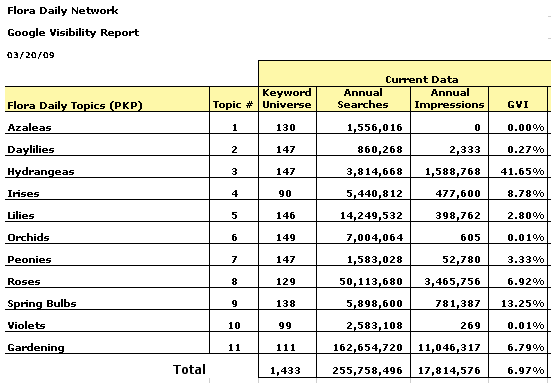 Search engine optimization strategies for positioning your online publishing business against the market leaders
Search engine optimization strategies for positioning your online publishing business against the market leaders
Analyzing a Google Visibility Report on your competitor’s website can help you go to market wisely.
Most experts would agree that keyword research is the first step toward obtaining a high Google SEO ranking.
Google is responsible for sending 30-50 percent of the organic traffic to most content-driven, publishing websites. Generally, that traffic centers on a keyword universe of 2,000 – 4,000 keyword phrases.
But how can you know with certainty that you’ll be able to crack the top 30 listings returned by Google for a search of your keyword terms? These are the 30 Google listings that get clicked on page one, two and three. Only you and your Mother will look past page three to find your listing.
When contemplating any investment in an online publishing venture, senior managers and investors always want evidence that you can achieve a significant market penetration against your keyword universe, compared to current market leaders.
So, how realistic are your goals for a 10 percent penetration?
An Online Market Audit will reveal both the size of your online market and your existing competitors.
It should identify the top primary keyword phrases that describe and define what your website will deliver and determine how many competitors you have for these keywords.
[text_ad]
How to gather and interpret simple online market intelligence
Compete Site Analytics is a free service that will reveal a website’s monthly unique visitor count and thus the largest websites in your space.
Compete Search Analytics enables you to discover keywords driving traffic to any domain, identify gaps in your search strategy, and track your performance against competitors.
In many of our previous Mequoda Daily email newsletters and posts, we have cited Flora Daily, a fictional website for flower gardeners, as an example. We will do so again here.
Inasmuch as Flora Daily doesn’t exist (yet), we want to know if it could be competitive. We’ve done our Online Market Audit and discovered that, not surprisingly, gardening.about.com is one of the top websites in this category.
The About.com website is designed using Google-friendly principles, and is thus very well optimized for search. Compete and Google helped us to discover 1,433 keywords that are in the benchmark keyword universe for Flora Daily.
So, we loaded all of our 1,433 keyword phrases into another tool, Advanced Web Ranking (AWR), which queries Google for each of the keyword terms and determines where any website that is optimized for those terms ranks — position one, position five, position seven or somewhere farther back.
After about 20 hours of running time, AWR reported that of the 255 million annual searches for our 1,433 targeted keyword phrases, gardening.about.com has a 6.9 percent share or Google Visibility Index (GVI). That means the site gets about 17.8 million impressions annually from Google organic search.
So first we determined our competitors and our keyword universe.
Second, we determined the Google Visibility Index (GVI) for one of those competitors for our selected keyword universe. (Any website’s GVI is its estimated Google impressions divided by the estimated Google searches for a given keyword universe.)
Next, we can estimate arrivals from Google organic search to gardening.about.com at 1.78 million per year (or 150,000 per month) based on an industry average click-through rate of 10 percent.
In summary, if a website’s keyword universe gets 20 million searches per month, and its GVI is 10 percent, then two million of that website’s Google listings will be seen by users every month. And if we get an industry average Google click-through rate of 10 percent, then 200,000 users per month will show up at this online publisher’s website via Google organic search.
In other words, on a universe that has 20 million searches per month, we can be seen by two million searchers (10 percent), and clicked on by 200,000 searchers (10 percent).
That’s our Google funnel. Twenty million searches = two million impressions = 200,000 arrivals.
On a standard Mequoda Periodical Website (aka: an Internet Hub), we can expect to convert four percent of those arrivals into email subscribers. If we can hold a four percent monthly email conversion rate (ECR), after five years, we’ll have 222,000 net active email subscribers (assuming a 97-percent monthly retention rate).
[text_ad]
How can we know if the 10 percent Google Visibility Index (GVI) is realistic?

We believe that Flora Daily is capable of achieving between a five and 10 percent market penetration in this category after five years.
That’s because About.com is earning the bulk of its Google Visibility Index against the gardening keyword cluster. Out of 18 million impressions at About.com, approximately 11 million of them come from the gardening keyword cluster. The site is optimized against its gardening über keyword cluster.
Our editorial plan for Flora Daily is to target 10 flowers types, plus gardening in general. About.com has targeted gardening as a primary keyword phrase, plus a number of popular clusters including spring bulbs and hydrangeas. This merits a deeper investigation into how About.com gets such a high score for spring bulbs and hydrangeas.
Significantly, About.com is not targeting some flower types, and publishes little content about them. This spells opportunity and indicates where it could be relatively easy to score highly and displace other competitors in the top 30 sites returned by Google.
Notably, there is opportunity in orchids, where there are 7 million searches, but a GVI of only .01 percent for About.com.
The art and science of choosing keyword phrases
There is no substitute for subject matter knowledge and creativity, combined with a solid understanding of what phrases users are searching, and what phrases are helping other websites to rank highly.
For instance, there appears to be opportunity for roses as well, but “roses” represents a problematic keyword cluster to target. That’s because much of the Google search volume for keyword phrases in the “roses” keyword cluster have nothing to do with gardening and is the result of people buying cut flowers online.
If interested in gardening, the two-word phrases Google searchers will use are growing roses, fertilizing roses, and pruning roses.
Our conclusion is that there is still plenty of room for competition in almost any market you want to compete in, if you do your research intelligently and diligently.



Of course, what a great site and informative posts, I will add backlink – bookmark this site? Regards, Brand Expert.